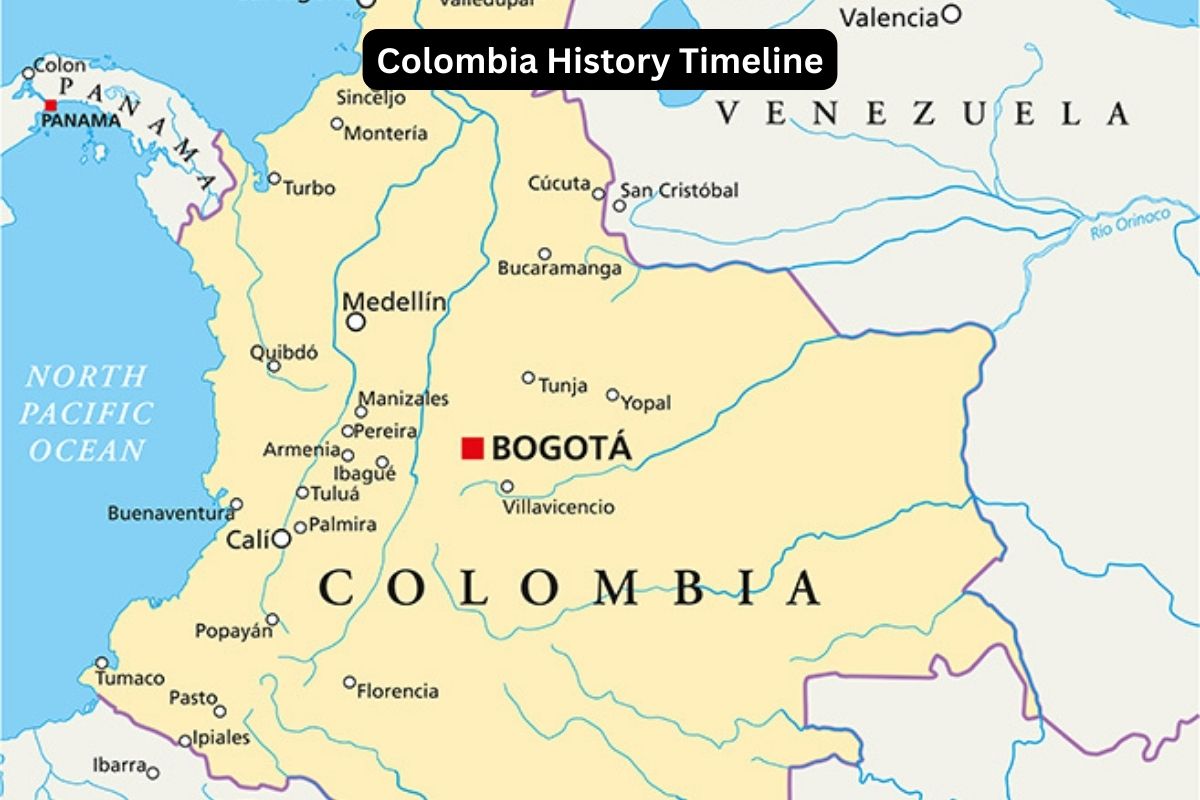Colombia’s history is a tapestry woven with threads of ancient civilizations, colonial conquests, independence struggles, and modern-day challenges.
From the earliest evidence of human habitation to the recent peace agreement that ended decades of armed conflict, Colombia’s past is marked by resilience, diversity, and transformation.
In this article, we delve into key milestones and events that have shaped Colombia’s trajectory, from pre-Columbian civilizations to the present day.
Join us on a journey through time to discover the vibrant tapestry of Colombia’s history.
| Year | Event |
|---|---|
| 12,000 BCE | Evidence of human habitation in present-day Colombia. |
| 3000 BCE – 1000 BCE | Development of pre-Columbian civilizations including the San Agustín, Tierradentro, and Tayrona cultures. |
| 1499 | Spanish explorer Alonso de Ojeda explores the northern coast of South America, including present-day Colombia. |
| 1536 – 1538 | Gonzalo Jiménez de Quesada leads the Spanish conquest of the Muisca Confederation, establishing the city of Santa Fe de Bogotá (modern-day Bogotá) in 1538. |
| 1717 | Formation of the Viceroyalty of New Granada, with Bogotá as its capital. |
| 1810 | Independence movement begins in Colombia, inspired by other Latin American independence movements. |
| 1819 | Simón Bolívar leads the liberation forces to victory at the Battle of Boyacá, securing Colombia’s independence from Spain. |
| 1821 | Gran Colombia is established, comprising modern-day Colombia, Ecuador, Panama, and Venezuela. |
| 1831 | Gran Colombia dissolves, and Colombia becomes its own independent republic. |
| 1899 – 1902 | Thousand Days’ War, a civil conflict between liberals and conservatives, devastates the country. |
| 1903 | Panama declares independence from Colombia with the support of the United States, leading to the creation of the Panama Canal Zone. |
| 1930s – 1940s | La Violencia, a period of political and social unrest marked by violence between liberals and conservatives. |
| 1958 | Establishment of the National Front, a power-sharing agreement between liberals and conservatives aimed at ending La Violencia. |
| 1964 | Formation of the Revolutionary Armed Forces of Colombia (FARC), a Marxist guerrilla group. |
| 1985 | M-19, another guerrilla group, lays down its arms and becomes a political party. |
| 1991 | Adoption of a new constitution, which introduces significant political and social reforms, including the recognition of indigenous and Afro-Colombian rights. |
| 2000s | Intensification of the conflict between government forces, paramilitary groups, and guerrilla organizations like FARC. |
| 2016 | Peace agreement signed between the Colombian government and FARC, formally ending more than five decades of conflict. |
| 2018 | Conservative politician Iván Duque becomes president of Colombia, succeeding Juan Manuel Santos. |
Timeline of the History of Colombia
12,000 BCE: Evidence of human habitation in present-day Colombia
Archaeological evidence suggests that humans have inhabited the region now known as Colombia since around 12,000 BCE.
These early inhabitants were likely nomadic hunter-gatherers who relied on hunting, fishing, and gathering wild plants for sustenance.
Also Read: Historical Facts About Colombia
Over time, these hunter-gatherer societies developed more settled communities and began cultivating crops such as maize, beans, and squash.
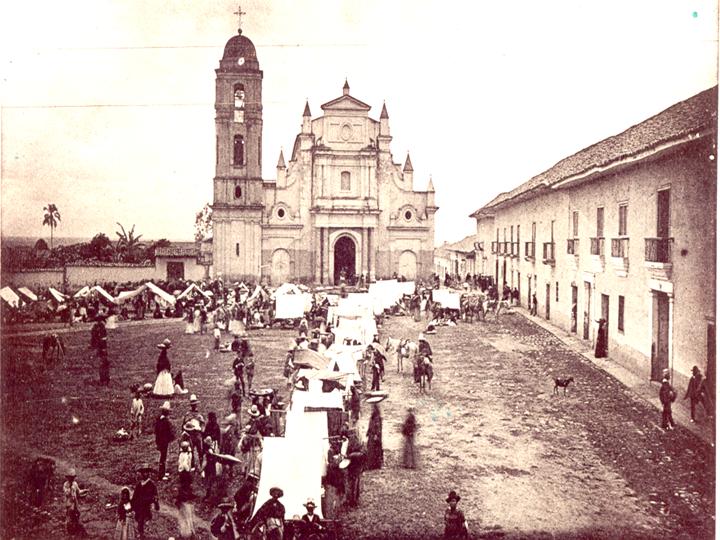
3000 BCE – 1000 BCE: Development of pre-Columbian civilizations
During this period, several advanced civilizations emerged in different regions of present-day Colombia. Among the most notable were the San Agustín, Tierradentro, and Tayrona cultures.
The San Agustín culture, centered in the southern part of Colombia, is renowned for its elaborate stone sculptures and tombs, which are UNESCO World Heritage sites today. These sculptures depict mythical beings, animals, and supernatural creatures, offering insights into the spiritual beliefs of the San Agustín people.
Also Read: Pablo Escobar Facts
Tierradentro, located in the Andean highlands, is known for its underground tombs and elaborate burial chambers. These tombs, carved into the rocky landscape, feature intricate geometric designs and wall paintings, providing valuable clues about Tierradentro’s social organization and religious practices.
The Tayrona culture thrived along Colombia’s northern coast, particularly in the Sierra Nevada de Santa Marta region. The Tayrona people were skilled artisans, known for their goldwork, ceramics, and stone carvings. They also developed complex agricultural systems, including terraced farming and irrigation techniques.
1499: Spanish exploration of the northern coast
In 1499, Spanish explorer Alonso de Ojeda led an expedition to the northern coast of South America, including present-day Colombia. Ojeda’s voyage was part of Spain’s efforts to explore and colonize the newly discovered lands of the Americas.
During his journey, Ojeda made contact with various indigenous groups along the coast, including the Wayuu and Guajira peoples. He also explored the Gulf of Urabá and the Magdalena River delta, laying the groundwork for subsequent Spanish expeditions and eventual colonization of the region.
Ojeda’s exploration paved the way for further Spanish incursions into Colombia and set the stage for the subsequent arrival of conquistadors, missionaries, and settlers seeking to establish Spanish dominion over the territory.
1536 – 1538: Spanish conquest of the Muisca Confederation
Gonzalo Jiménez de Quesada, a Spanish conquistador, led an expedition into the interior of present-day Colombia in search of El Dorado, the mythical city of gold. In the process, he encountered and conquered the indigenous Muisca Confederation.
The Muisca people inhabited the highlands surrounding the Bogotá savanna and were known for their advanced agricultural techniques, goldworking skills, and complex social organization.
Jiménez de Quesada’s expedition culminated in the founding of Santa Fe de Bogotá (modern-day Bogotá) in 1538, which served as the capital of the newly established New Kingdom of Granada, a Spanish colonial administrative district.
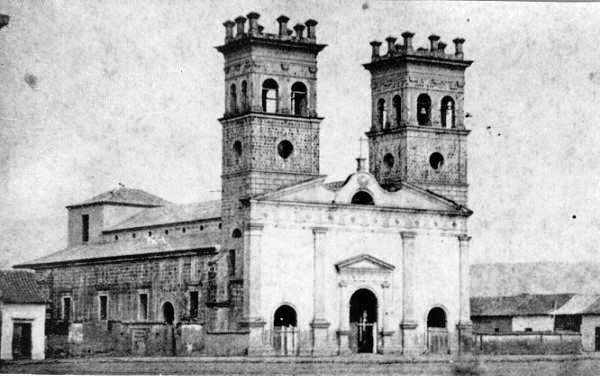
1717: Formation of the Viceroyalty of New Granada
The Viceroyalty of New Granada was established in 1717 as part of Spain’s administrative reorganization of its South American colonies. It encompassed territories that roughly correspond to present-day Colombia, Ecuador, Panama, and Venezuela.
Bogotá, located in the heart of the Andean region, was designated as the capital of the Viceroyalty of New Granada. As the political, economic, and cultural center of the viceroyalty, Bogotá played a crucial role in Spanish colonial governance and trade.
1810: Independence movement begins in Colombia
Inspired by the ideals of the Enlightenment and the success of other Latin American independence movements, Colombian patriots initiated a rebellion against Spanish colonial rule in 1810.
The independence movement was fueled by grievances over taxation, trade restrictions, and the monopolistic control exercised by Spain over the colony’s economy.
The city of Bogotá became a focal point of revolutionary activity, with prominent figures such as Antonio Nariño and Camilo Torres leading the charge for independence.
The events of 1810 marked the beginning of a protracted struggle for liberation from Spanish colonial domination, culminating in Colombia’s eventual independence in 1819 under the leadership of Simón Bolívar.
1819: Simón Bolívar leads the liberation forces at the Battle of Boyacá
In 1819, Simón Bolívar, a Venezuelan military and political leader, led a decisive campaign against Spanish royalist forces in Colombia.
The culmination of this campaign was the Battle of Boyacá on August 7, 1819, where Bolívar’s forces achieved a decisive victory over the Spanish army.
The Battle of Boyacá is considered one of the pivotal moments in the South American Wars of Independence, as it secured Colombia’s independence from Spanish rule.
Following this victory, Bolívar continued his military campaigns across the region, ultimately contributing to the liberation of several Latin American countries from Spanish colonial control.
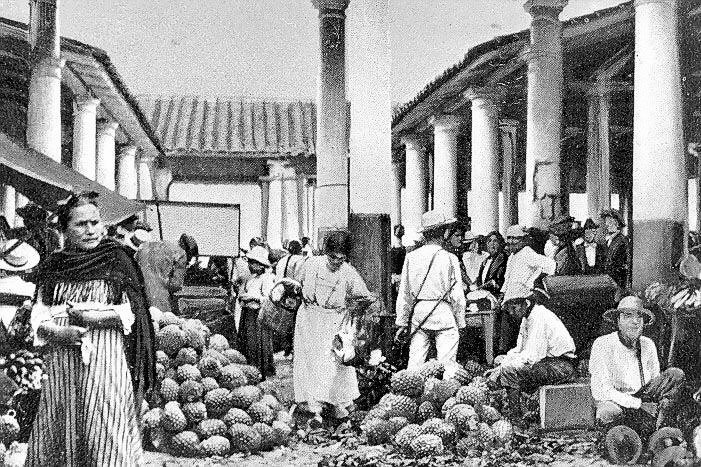
1821: Establishment of Gran Colombia
In 1821, the independent nations of Colombia, Ecuador, Panama, and Venezuela came together to form the Republic of Gran Colombia, a federation of states united under a single government.
Gran Colombia was envisioned as a political entity that would promote unity and cooperation among its member states, fostering economic development and regional integration.
Simón Bolívar played a central role in the establishment of Gran Colombia and was appointed as its first president.
The creation of Gran Colombia marked a significant milestone in the history of Latin American independence movements and reflected the aspirations of the region’s leaders for a unified and prosperous future.
1831: Dissolution of Gran Colombia
Despite its lofty goals, Gran Colombia faced numerous challenges, including internal political divisions and regional tensions.
In 1831, Gran Colombia dissolved following a period of political instability and disagreements among its leaders.
The dissolution of Gran Colombia led to the emergence of several independent nations, including present-day Colombia, Ecuador, and Venezuela, each with its own government and administration.
The breakup of Gran Colombia underscored the complexities of nation-building in post-colonial Latin America and the difficulties of maintaining unity in diverse and geographically vast regions.
1899 – 1902: Thousand Days’ War
The Thousand Days’ War was a civil conflict that erupted in Colombia between conservative and liberal factions from 1899 to 1902.
The war was sparked by longstanding political and social tensions between the two factions, including disputes over land ownership, economic policies, and religious freedom.
The conflict resulted in widespread violence, devastation, and loss of life, as both sides engaged in guerrilla warfare, battles, and reprisals against civilian populations.
The Thousand Days’ War had profound and lasting consequences for Colombia, deepening divisions within society and exacerbating existing political and economic challenges.
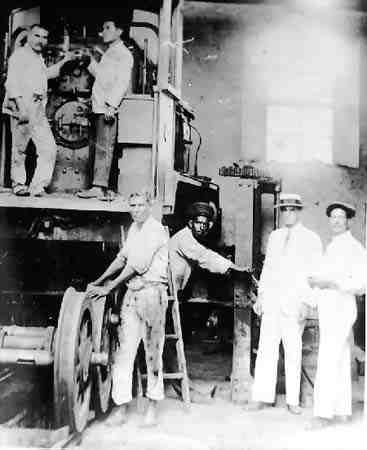
1903: Panama declares independence from Colombia
In 1903, Panama, then a province of Colombia, declared its independence from Colombian rule.
The independence movement in Panama was fueled by grievances over political marginalization, economic exploitation, and a desire for greater autonomy.
The United States, which sought to build and control a canal across the isthmus of Panama to connect the Atlantic and Pacific Oceans, supported Panama’s bid for independence.
With the backing of the United States military, Panama successfully seceded from Colombia and established itself as an independent nation on November 3, 1903.
1930s – 1940s: La Violencia
La Violencia was a period of widespread political and social unrest in Colombia during the 1930s and 1940s.
The violence was fueled by deep-seated socio-economic inequalities, political instability, and longstanding regional tensions.
La Violencia pitted conservative factions against liberal groups, resulting in armed conflicts, massacres, and reprisals that claimed the lives of hundreds of thousands of Colombians.
The violence of this period had a profound impact on Colombian society, exacerbating existing divisions and contributing to cycles of revenge and retaliation that would persist for decades.
1958: Establishment of the National Front
The National Front was a political agreement established in Colombia in 1958 to end the period of La Violencia and promote stability and reconciliation.
The agreement was brokered between the two major political parties in Colombia, the Conservative Party and the Liberal Party.
Under the terms of the National Front, power would be alternated between the two parties, with each party holding the presidency for a term of four years.
The National Front aimed to prevent further violence and foster a spirit of cooperation and compromise between political factions in Colombia.
1964: Formation of the Revolutionary Armed Forces of Colombia (FARC)
The Revolutionary Armed Forces of Colombia (FARC) is a Marxist guerrilla group founded in 1964 with the aim of overthrowing the Colombian government and establishing a communist state.
FARC emerged in response to widespread social inequality, political repression, and land disputes in rural areas of Colombia.
Initially, FARC focused on guerrilla warfare and armed resistance against government forces, often targeting military installations, infrastructure, and economic interests.
Over the decades, FARC evolved into one of the most powerful and influential insurgent groups in Colombia, controlling large swathes of territory and engaging in activities such as drug trafficking, extortion, and kidnapping to fund its operations.
1985: M-19 lays down its arms
M-19, short for the 19th of April Movement, was a Colombian guerrilla group formed in 1970.
Initially, M-19 aimed to address social and economic inequalities through armed struggle and revolutionary actions.
However, in 1985, after years of conflict, M-19 decided to lay down its arms and transition into a political party.
The decision to demobilize came after negotiations with the Colombian government, which offered amnesty and the opportunity to participate in the political process.
M-19 subsequently transformed into a legal political party, advocating for its goals through peaceful means within the framework of Colombia’s democratic institutions.
1991: Adoption of a new constitution
In 1991, Colombia adopted a new constitution, replacing the previous one dating back to 1886.
The new constitution introduced significant political and social reforms aimed at addressing longstanding issues of governance, human rights, and decentralization.
Key provisions of the 1991 constitution include the recognition of fundamental rights and liberties, the establishment of a system of checks and balances between the executive, legislative, and judicial branches of government, and the promotion of cultural diversity and multiculturalism.
Additionally, the constitution granted greater autonomy to Colombia’s regions and recognized the rights of indigenous peoples and Afro-Colombian communities.
The adoption of the 1991 constitution marked a milestone in Colombia’s transition to a more inclusive and democratic society.
2000s: Intensification of the conflict
Despite efforts to negotiate peace and address the root causes of the conflict, the 2000s saw an intensification of the armed conflict in Colombia.
Government forces, paramilitary groups, and guerrilla organizations like FARC continued to engage in hostilities, resulting in widespread violence, displacement, and human rights abuses.
The conflict was fueled by various factors, including territorial disputes, control over drug trafficking routes, and resistance to government authority.
Efforts to reach a negotiated settlement were complicated by deep-seated mistrust, competing interests, and the presence of illegal armed groups operating outside the bounds of the law.
The intensification of the conflict underscored the challenges of achieving lasting peace and stability in Colombia and the need for sustained efforts to address the underlying causes of violence and insecurity.
2016: Peace agreement with FARC
In 2016, the Colombian government and the Revolutionary Armed Forces of Colombia (FARC) signed a historic peace agreement, formally ending more than five decades of armed conflict.
The peace agreement included provisions for disarmament, demobilization, and reintegration of FARC fighters into civilian life.
It also addressed key issues such as rural development, political participation, transitional justice, and the eradication of illicit drug cultivation.
The peace agreement was hailed as a significant step towards reconciliation and stability in Colombia, although its implementation faced challenges and setbacks.
Despite ongoing obstacles, the peace agreement represented a landmark achievement in Colombia’s quest for peace and offered hope for a brighter and more prosperous future for all Colombians.
